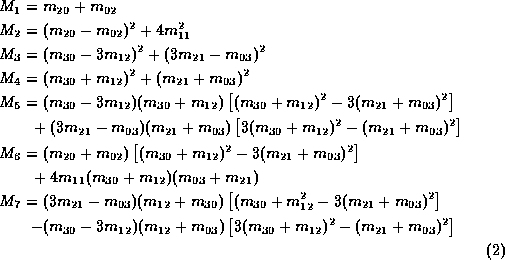


Next: Pattern Recognition
Up: Object Recognition
Previous: Object Recognition
We can use simple descriptions (one numeric value) to represent
features on and hence recognise objects:
- They provide a simple means of comparison.
- They can provide position and orientation information (i.e. Moments
etc.)
- Too simplistic for some applications
- Do not give a unique means of identification.
Such numeric or statistical descriptions may be divided into two distinct
classes:
- Geometric descriptions: area, length, perimeter,
elongation, compactness, moments of inertia.
- Topological descriptions: connectivity and Euler
number.
Some of the above measures have
obvious meanings. The others will be
described briefly below in the context of two-dimensional images.
- Elongation
- -- sometimes called
eccentricity. This is the ratio of the maximum
length of line or chord that spans the region to
the minimum length chord. We can also define this in terms of
moments as we will see shortly.
- Compactness
- -- this is the ratio of the square of the
perimeter to the area of the region.
- Moments of Inertia
- --
the ijth discrete central moment
 of
a region is defined by
of
a region is defined by

where the sums are taken over all points (x,y)
contained within the region and  is the centre of
gravity of the region:
is the centre of
gravity of the region:

Note that, n, the total number of points
contained in the region, is a measure of its area.
We can form seven new moments from the
central moments that are invariant to
changes of position, scale and orientation of the object represented
by the region (invariants will be discussed below shortly), although
these new moments are not invariant under perspective
projection. For moments of order up to three, these are:

We can also define
eccentricity using moments as

We can also find principal axes of inertia
that define a natural coordinate system for a region. Let
 be given by
be given by

We will get two values for  which are
which are  apart. The
pair of lines which make an angle
apart. The
pair of lines which make an angle  with the x axis
passing through the centre of gravity of the region define a pair of
principal axes which are generally aligned along what
would intuitively be called the length and width of the region.
with the x axis
passing through the centre of gravity of the region define a pair of
principal axes which are generally aligned along what
would intuitively be called the length and width of the region.
- Connectivity
- -- the number of
neighbouring features adjoining the region.
- Euler Number
- -- for a single region, one
minus the number of holes in that region. The Euler number for a set
of connected regions can be calculated as the number of regions minus
the number of holes.
Most of these statistical measures may be useful in helping to control
image reasoning and recognition, even if they are not sufficient for
reasoning or recognition by themselves.
However,
these measures are very cheap to calculate as byproducts of the
segmentation strategies detailed, especially region growing.
Consequently, when these measures are used in conjunction with other
reliably extracted features, they can help to improve recognition
techniques by constraining the search space for matches
between image and object features.
Invariant Measures
Several of the statistical measures we have met are
invariant measures, which is to say that the value of the measure
does not vary with, for example, the position of the region in the
image, or perhaps its orientation or scale.
This is clearly a good property as we cannot guarantee viewing an object from
identical viewpoints.
Thus, while the centre of
gravity of a region obviously varies with its position, its area
does not. While area does vary with scale (and thus closeness of
the camera to the object, for example), compactness
as defined above is invariant with respect to scale as well as
position and orientation.
Other invariant measures are:



Next: Pattern Recognition
Up: Object Recognition
Previous: Object Recognition
dave@cs.cf.ac.uk
